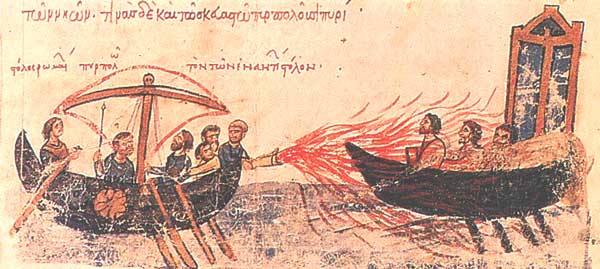|
|
Depiction of Greek Fire in the Madrid Skylitzes manuscript Greek Fire (also called Byzantine Fire and liquid fire) was a weapon used by the Byzantine Empire, said to have been invented by a Syrian Christian refugee named Kallinikos (Callinicus) of Heliopolis, probably about 673. Some people believe that he acquired this knowledge from the chemists of Alexandria. It was capable of discharging a stream of burning fluid, and was very effective both on sea and land, but it was used primarily at sea. It is rumored that the key to Greek Fire's effectiveness was that it would continue burning under almost any conditions, even under water. Enemy ships were often afraid to come too near the Byzantine fleet because, once within range, the fire gave the Byzantines a strong advantage. Byzantine fire was largely responsible for many Byzantine military victories, and partly the reason for the Empire surviving as long as it did, particularly near the end of the Empire when there were not enough inhabitants of the empire to effectively defend it. It was first used to repel the Arab siege of Constantinople in 674-677 (battle of Syllaeum), and 717-718, against the Varangians (Vikings) in 941 and against the Venetians during the Fourth Crusade. It quickly became one of the most fearsome weapons of the medieval world; the mere sight of any sort of siphon, whether it was used for Greek Fire or not, was often enough to defeat an enemy. It was, however, hard to control, often accidentally setting Byzantine ships on fire as well.
J. H Haldon, M. Byrne, A possible solution of the Greek Fire Manufacture The process of manufacturing the fluid was a very carefully guarded military secret — so secret, in fact, that today we still do not know how it was made. Various sources speculate that its constituents may have included sulfur, quicklime, and liquid petroleum. It is not clear if the mixture was ignited by a flame as the mixture emerged from the syringe, or that it ignited spontaneously when it came into contact with water. If the latter is the case, it is possible that the ingredient responsible was calcium phosphide, made by heating lime, bones and charcoal. On contact with water, calcium phosphide releases phosphine, which ignites spontaneously. These materials were apparently heated in a cauldron, and then pumped out through a siphon or large syringe, known as a siphonarios mounted on the bow of the ship. It could also be used in hand grenades, made of earthenware vessels.
A publication about Greek Fire, (requires free available DJVU Viewer) References W. H. Spears (1969), Greek Fire: The Fabulous Secret Weapon That Saved Europe Retrieved from "http://en.wikipedia.org/"
 |
|
|||||||||||||||||

